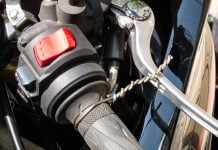Battery
Many motorcycle batteries aren’t sealed and sporadically need to have the water level completed. On the side of the battery you’ll find the “minimum and maximum” marks. Disconnect the battery (first remove the negative pole), remove it from the motorcycle, open all caps and fill the level with distilled water sold at gas stations and pharmacies – ordinary water oxidises the metal plates inside the battery. Don’t use mineral or tap water. In summer, in hot regions or on daytime bikes parked in the sun, this check has to be more frequent. When reassembling the battery, be sure to clean the poles and turn on the positive one first.
Cables
The brake, throttle and clutch cables should also be checked periodically. The brake can leave you on foot or compromise safety. It’s easy to check: in the case of the front drum brake and the clutch, move the rubber guard away from the levers and check the condition of the steel cables. Replace if frayed. Checking the throttle cable and replacing should be done at a dealer.
Chain
The chain loses lubrication faster in rainy periods and when it travels in areas with a lot of dirt, dust or sand. If riding a motorcycle under heavy rain, lubricate the chain with SAE 80-90 oil before the next exit (apply over the full length of the chain with a brush or toothbrush). Lubrication reduces friction with the crown and pinion and makes the three components last longer. Under normal conditions of use, on asphalt, lubricate every 500 km.
As the bike gains mileage, the chain slowly gains clearance. Over time you’ll notice that it will be bulging down. When this clearance exceeds that indicated in the owner’s manual, you must adjust it so that you don’t risk loosening the crown when the motorcycle is in motion. Use a finger or screwdriver to push the chain down and see how much it gives. The original set of tools is sufficient to stretch the chain and the prosecute is also in the owner’s manual. Basically, it’s done by releasing the rear axle and pushing it back into the swingers of the suspension along with the wheel. Excessive tightening can cause disruption.
Air Filter
Some bikes employ disposable air filters for ease of maintenance, but most low-displacement models feature fam elements. These should be washed with neutral detergent every 1000km, and less so if the bike circulates in places with a lot of dust or sand. After this cleaning, some manufactures recommend applying SAE 80-90 oil to the foam.
Brake System
In the case of the disc system, it’s possible to see if the pads are close to the limit facing the wheel. The pads are formed by a metal base (where they’re attached to the brake calliper) and the friction material, which visually is a “step” that’s in contact with the disc. It can’t be less than 1mm thick, and is ideal to check every 1000km. Don’t let the tablet run out, because this economy is expensive: if the metal base comes in contact with the disk, it will damage it and you’ll need to buy a new one. On the drum models, there are indicators of the adjustment limit of the shoes. Adjusting the drum brake is necessary as the shoes wear out and the gap becomes more than 3cm until the brake is engaged when depressing the pedal.
Engine Oil
Good quality lubricating oil is vital for engine durability. In addition to reducing wear between parts such as cylinder and rings, the lubricant helps to cool the engine and reduces friction at the gearbox. Changing the lubricant by following the correct timing and specifications stated in the owner’s manual is one of the most inexpensive ways to conserve your engine. Choose the manufacturer of your choice, but always follow the viscosity recommendation for which your engine was designed (eg 20W50).
Check that the lubricating oil level is not below the recommended minimum for every 1,000 km at least. To do this, wait 1 to 5 minutes after use and place the bike on level ground. Most models need to be upright and not tilted on the side stand, which results in a difference in reading (see your motorcycle manual). Remove the filler cap, clean the dipstick and insert again without threading to check the oil level, which should be between the “minimum” and “maximum” marks. If it is below the minimum level, complete with the same lubricant until it reaches the correct level.
In the oil bottle you also find the oil performance API ratings, by letters like SJ, SL and SM. Being of the same viscosity, API SL oil meets a more demanding classification than an SJ API, for example (and so on, in alphabetical order). You can opt for a higher grade API oil whenever you wish, as long as you respect the viscosity indication determined by the motorcycle manufacturer.
Tires
Stopping at the station is a good opportunity to check tire calibration. The correct procedure is for cold tires, so you prefer to stop at the closest station – when the tire heats up in contact with the floor, the internal air pressure increases and the pump identifies a higher pressure. Use the pressure stated by the bike manufacturer in the owner’s manual or sticker that is usually attached to the swingarm of the rear suspension.
Even if the tires are not yet worn out, they need to be replaced if they are five years old. The problem is that the rubber stiffens and dries over the years, and this reduces the ability to adhere to the asphalt, which can cause slippage. The fabrication date is stamped on the side of the tire, next to the “DOT” (Department of Transportation) inscription. It is a sequence of four numbers, in which the first two reveal the week in which it was produced and the last two, the year of manufacture. For example: “0313” means that it was produced in the third week of 2013.
When the grooves of the tire reach the minimum depth, it is time to change it. The grooves serve to drain the water in wet conditions and avoid loss of grip. To prevent the tire from becoming unsafe, or for the grooves to disappear so that afterwards you realize that you should have replaced it, every tire has TWI inscription (Tread Wear Indicator) . Looking at the groove next to the letters TWI you will find small bumps. Simply change the tire when the tread height matches those shoulders.
Spark Plugs
The spark plug is important because it produces the spark in the air-fuel mixture inside the engine, which makes your bike ride. When it spends, it makes fuel consumption rise, as does the emission of pollutants. Change them according to the manual and check their status every 3,000 km. The clearance between the electrodes should be about 0.8 millimeter and needs to be adjusted when buying a new candle.


































